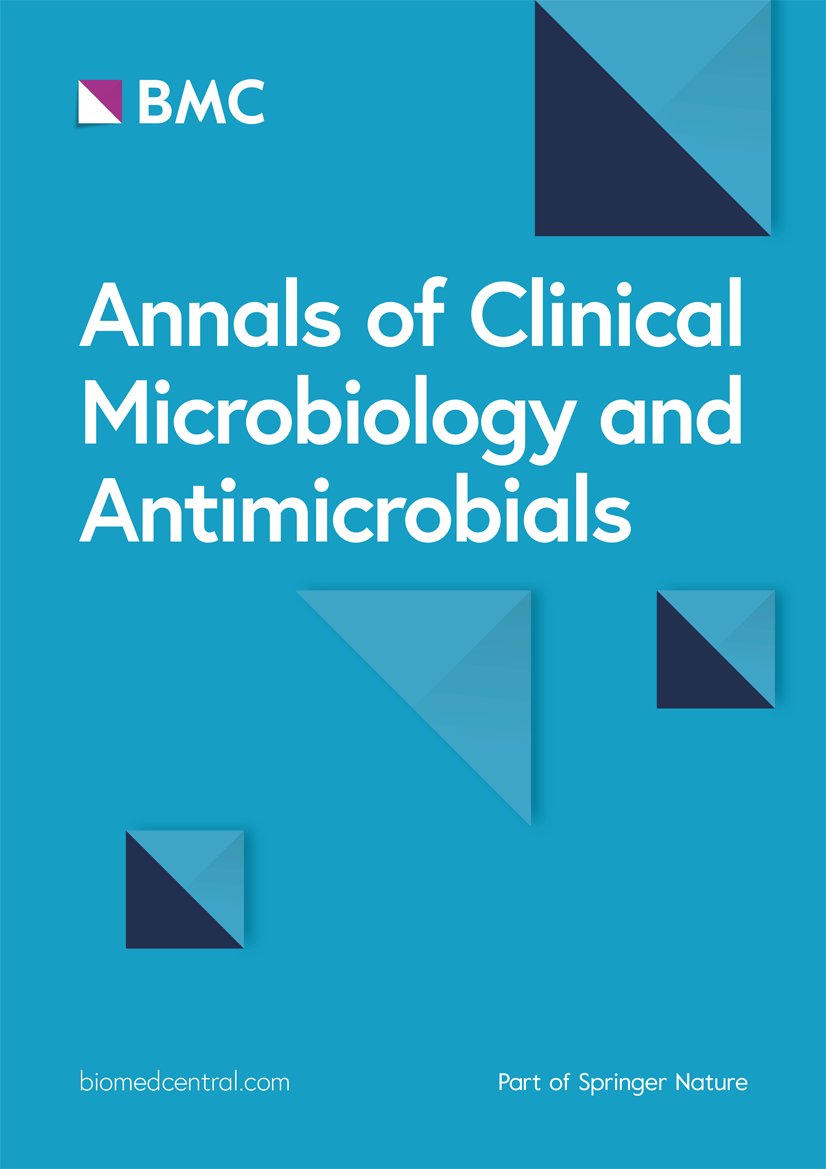Recombination-mediated dissemination of Methicillin-resistant S. aureus clonal complex 1 in the Egyptian health care settings
IF 4.6
2区 医学
Q1 MICROBIOLOGY
Annals of Clinical Microbiology and Antimicrobials
Pub Date : 2023-12-14
DOI:10.1186/s12941-023-00659-y
引用次数: 0
Abstract
Methicillin-resistant Staphylococcus aureus (MRSA) is a rapidly evolving pathogen that is frequently associated with outbreaks and sustained epidemics. This study investigated the population structure, resistome, virulome, and the correlation between antimicrobial resistance determinants with phenotypic resistance profiles of 36 representative hospital-acquired MRSA isolates recovered from hospital settings in Egypt. The community-acquired MRSA lineage, clonal complex 1 (CC1) was the most frequently detected clone, followed by three other globally disseminated clones, CC121, CC8, and CC22. Most isolates carried SCCmec type V and more than half of isolates demonstrated multi-drug resistant phenotypes. Resistance to linezolid, a last resort antibiotic for treating multidrug resistant MRSA, was observed in 11.11% of the isolates belonging to different genetic backgrounds. Virulome analysis indicated that most isolates harboured a large pool of virulence factors and toxins. Genes encoding aureolysin, gamma hemolysins, and serine proteases were the most frequently detected virulence encoding genes. CC1 was observed to have a high pool of AMR resistance determinants including cfr, qacA, and qacB genes, which are involved in linezolid and quaternary ammonium compounds resistance, as well as high content of virulence-related genes, including both of the PVL toxin genes. Molecular clock analysis revealed that CC1 had the greatest frequency of recombination (compared to mutation) among the four major clones, supporting the role of horizontal gene transfer in modulating AMR and hypervirulence in this clone. This pilot study provided evidence on the dissemination success of CA-MRSA clone CC1 among Egyptian hospitals. Co-detection of multiple AMR and virulence genes in this lineage pose a broad public health risk, with implications for successful treatment. The results of this study, together with other surveillance studies in Egypt, should be used to develop strategies for controlling MRSA infections in Egyptian health-care settings.重组介导的耐甲氧西林金黄色葡萄球菌克隆复合体 1 在埃及医疗机构中的传播
耐甲氧西林金黄色葡萄球菌(MRSA)是一种快速发展的病原体,经常与疾病爆发和持续流行有关。本研究调查了从埃及医院环境中回收的 36 株具有代表性的医院获得性 MRSA 分离物的种群结构、耐药性组、毒力组以及抗菌药耐药性决定因素与表型耐药性特征之间的相关性。社区获得的 MRSA 株系--克隆复合体 1(CC1)是最常检测到的克隆,其次是其他三个全球传播的克隆--CC121、CC8 和 CC22。大多数分离株携带 SCCmec V 型,一半以上的分离株表现出多重耐药表型。对利奈唑胺(治疗耐多药 MRSA 的最后一种抗生素)产生耐药性的分离株占 11.11%,这些分离株属于不同的遗传背景。病毒组分析表明,大多数分离株都含有大量毒力因子和毒素。最常检测到的毒力编码基因是金黄色溶菌酶、γ溶血素和丝氨酸蛋白酶。据观察,CC1含有大量AMR抗性决定基因,包括cfr、qacA和qacB基因,这些基因参与了利奈唑胺和季铵化合物的抗性,同时还含有大量毒力相关基因,包括两种PVL毒素基因。分子钟分析表明,在四个主要克隆中,CC1的重组频率(与突变相比)最高,这支持了水平基因转移在调节该克隆的AMR和高病毒性中的作用。这项试点研究为CA-MRSA克隆CC1在埃及医院中的成功传播提供了证据。在这一血统中同时检测到多种 AMR 基因和毒力基因,构成了广泛的公共卫生风险,并对成功治疗产生了影响。这项研究的结果以及埃及的其他监测研究结果应被用于制定埃及医疗机构控制 MRSA 感染的策略。
本文章由计算机程序翻译,如有差异,请以英文原文为准。
求助全文
约1分钟内获得全文
求助全文
来源期刊

Annals of Clinical Microbiology and Antimicrobials
MICROBIOLOGY-
CiteScore
8.60
自引率
0.00%
发文量
49
审稿时长
>12 weeks
期刊介绍:
Annals of Clinical Microbiology and Antimicrobials considers good quality, novel and international research of more than regional relevance. Research must include epidemiological and/or clinical information about isolates, and the journal covers the clinical microbiology of bacteria, viruses and fungi, as well as antimicrobial treatment of infectious diseases.
Annals of Clinical Microbiology and Antimicrobials is an open access, peer-reviewed journal focusing on information concerning clinical microbiology, infectious diseases and antimicrobials. The management of infectious disease is dependent on correct diagnosis and appropriate antimicrobial treatment, and with this in mind, the journal aims to improve the communication between laboratory and clinical science in the field of clinical microbiology and antimicrobial treatment. Furthermore, the journal has no restrictions on space or access; this ensures that the journal can reach the widest possible audience.
 求助内容:
求助内容: 应助结果提醒方式:
应助结果提醒方式:


